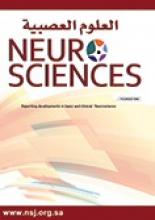Abstract
OBJECTIVE: To analyze all cases of childhood neuropathies (under 14 years of age) and report on their profile, pattern, clinical features and management.
METHODS: Children with acute flaccid paralysis, longstanding weakness of extremities, neuroregression and children receiving anti cancer drugs with symptoms suggestive of neuropathy were evaluated for evidence of peripheral neuropathy. The evaluation of children with acute flaccid paralysis was a prospective study from January 1992 through to December 2000. The rest of the patients were studied retrospectively from the hospital medical records, pediatric neurology outpatient clinic and the neurophysiology laboratory, Sultan Qaboos University Hospital, Al-Khod, Oman
RESULTS: Eighty-two (39 Male: 43 Female) children were found to have peripheral neuropathy. Acute Guillain-Barre syndrome was the most common with 37 children (45.1%), followed by genetic neuropathies [hereditary motor and sensory neuropathy with 17 (20.7%), hereditary sensory and autonomic neuropathy with 2 (2.4%), hereditary spastic paraplegia associated neuropathy with 9 (11%) and metachromatic leucodystrophy with 9 (11%)]. Chronic inflammatory demyelinating neuropathy was seen in 5 (6.1%) and vincristine induced neuropathy in 3 (3.5%) children.
CONCLUSION: Acute Guillain-Barre syndrome is the most common neuropathy amongst the acquired neuropathies. The treatable neuropathies constituted 54.7% (45 children) and the preventable genetic neuropathies accounted for the remaining 45.3% (37 children)
- Copyright: © Neurosciences
Neurosciences is an Open Access journal and articles published are distributed under the terms of the Creative Commons Attribution-NonCommercial License (CC BY-NC). Readers may copy, distribute, and display the work for non-commercial purposes with the proper citation of the original work.






